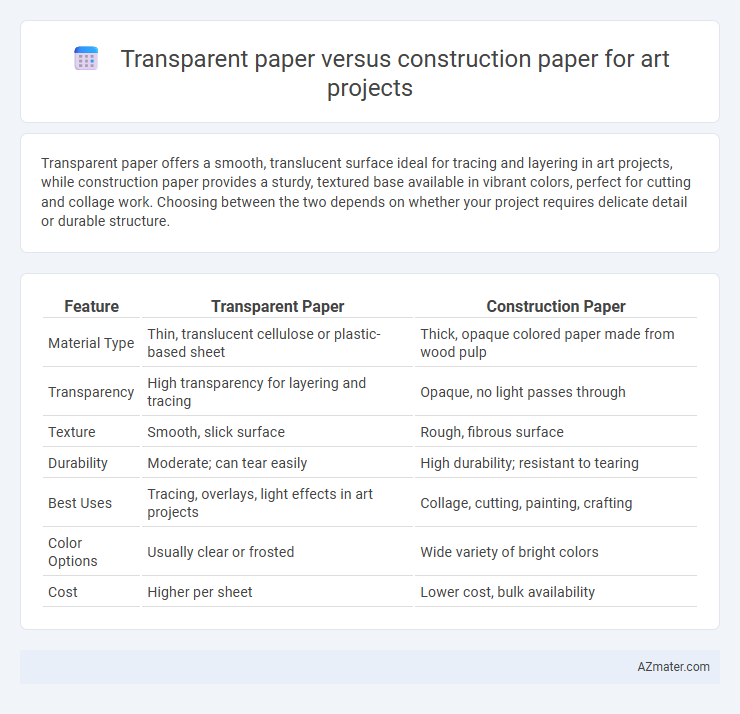Transparent paper offers a smooth, translucent surface ideal for tracing and layering in art projects, while construction paper provides a sturdy, textured base available in vibrant colors, perfect for cutting and collage work. Choosing between the two depends on whether your project requires delicate detail or durable structure.
Table of Comparison
| Feature | Transparent Paper | Construction Paper |
|---|---|---|
| Material Type | Thin, translucent cellulose or plastic-based sheet | Thick, opaque colored paper made from wood pulp |
| Transparency | High transparency for layering and tracing | Opaque, no light passes through |
| Texture | Smooth, slick surface | Rough, fibrous surface |
| Durability | Moderate; can tear easily | High durability; resistant to tearing |
| Best Uses | Tracing, overlays, light effects in art projects | Collage, cutting, painting, crafting |
| Color Options | Usually clear or frosted | Wide variety of bright colors |
| Cost | Higher per sheet | Lower cost, bulk availability |
Introduction to Transparent and Construction Paper
Transparent paper, often called tracing paper, is prized for its translucency and smooth surface, enabling artists to trace designs and overlay sketches with precision. Construction paper, made from coarse, colored fibers, offers a sturdy, versatile base ideal for cutting, folding, and layering in vibrant collage projects. Both materials serve distinct functions in art projects, with transparent paper excelling in detail work and construction paper providing bold color and durability.
Key Differences Between Transparent and Construction Paper
Transparent paper, often known as tracing paper, has a smooth, translucent surface ideal for overlaying and transferring designs, whereas construction paper is opaque, textured, and available in vibrant colors suited for cutting, folding, and creating bold shapes. Unlike construction paper, which is thicker and more durable for structural projects, transparent paper is thin and flexible, making it less suitable for three-dimensional art but perfect for layering techniques. The key differences lie in transparency, texture, thickness, and typical use cases in art projects where tracing or light transmission is required versus creating colorful, tactile elements.
Material Composition and Texture
Transparent paper, typically made from cellulose fibers, offers a smooth, glossy surface that enhances light transmission, ideal for tracing and overlay techniques in art projects. Construction paper consists of wood pulp fibers, resulting in a coarse, textured surface that absorbs ink and paint well, making it suitable for bold, tactile artworks. The differing material compositions and textures influence their use; transparent paper excels in precision work, while construction paper supports vibrant, textured creations.
Color Range and Opacity
Construction paper offers a wide color range, including vibrant, bold primary and secondary hues ideal for dynamic art projects, while transparent paper is available in more subtle, translucent shades that allow light to pass through. The opacity of construction paper is high, providing solid color coverage and excellent contrast, making it suitable for layered compositions or backgrounds. Transparent paper's low opacity enables unique effects like layering and light diffusion, enhancing dimensionality and visual interest in mixed-media artworks.
Versatility in Art Projects
Transparent paper offers excellent versatility for layering techniques, allowing artists to create depth and subtle color gradients in art projects. Construction paper provides a sturdy, vibrant base ideal for collages, cutouts, and mixed media applications due to its thickness and wide color range. Choosing between transparent and construction paper depends on the desired effect, with transparent paper enhancing translucency and construction paper supporting structural creativity.
Suitability for Various Art Techniques
Transparent paper excels in art projects requiring layering, tracing, and light manipulation due to its sheer quality, making it ideal for techniques like watercolor overlays, lightboxes, and detailed sketches. Construction paper offers a textured, opaque surface that suits collage, bold color application, and mixed media, providing durability and vibrant backgrounds for crafts involving cutting, gluing, and painting with acrylics or tempera. Artists often choose transparent paper for precision and subtle effects, while construction paper is favored for its robustness and vividness in hands-on art techniques.
Durability and Longevity
Construction paper offers greater durability and longevity for art projects due to its thick, fibrous texture that resists tearing and fading over time. Transparent paper, often made from vellum or tracing paper, is more fragile and prone to creasing or yellowing with prolonged exposure to light and handling. For projects requiring long-term preservation, construction paper is the superior choice.
Cost Comparison
Transparent paper typically costs more than construction paper due to its specialized production process and material quality, making it less budget-friendly for large art projects. Construction paper is widely available in bulk at affordable prices, providing an economical choice for students and hobbyists. For cost-sensitive art projects, construction paper offers a practical balance between quality and expense.
Eco-friendliness and Sustainability
Transparent paper, often made from cellulose fibers, is biodegradable and recyclable, making it a more eco-friendly choice for art projects compared to construction paper. Construction paper typically contains dyes and synthetic chemicals that can hinder biodegradability and create environmental concerns during production. Choosing transparent paper supports sustainability by reducing chemical waste and promoting materials that decompose more easily in natural environments.
Choosing the Right Paper for Your Art Project
Transparent paper offers a smooth surface ideal for tracing, layering, and creating detailed designs, making it perfect for projects requiring precision and light manipulation. Construction paper features a textured, sturdy quality available in vibrant colors, suitable for bold, tactile artworks and crafts that need durability. Selecting between transparent and construction paper depends on your project's need for translucency, color vibrancy, and structural support to achieve the desired artistic effect.

Infographic: Transparent paper vs Construction paper for Art project
 azmater.com
azmater.com